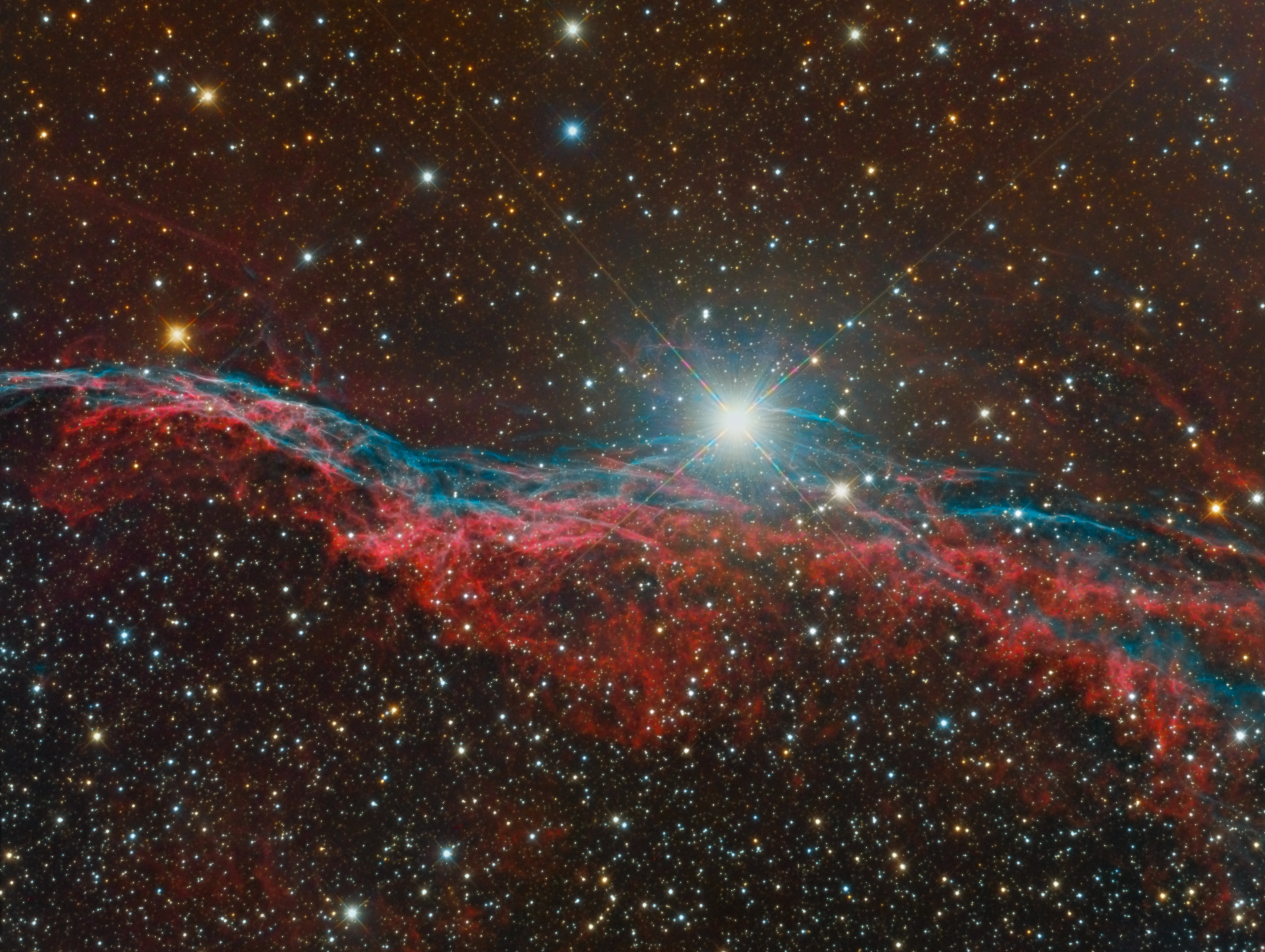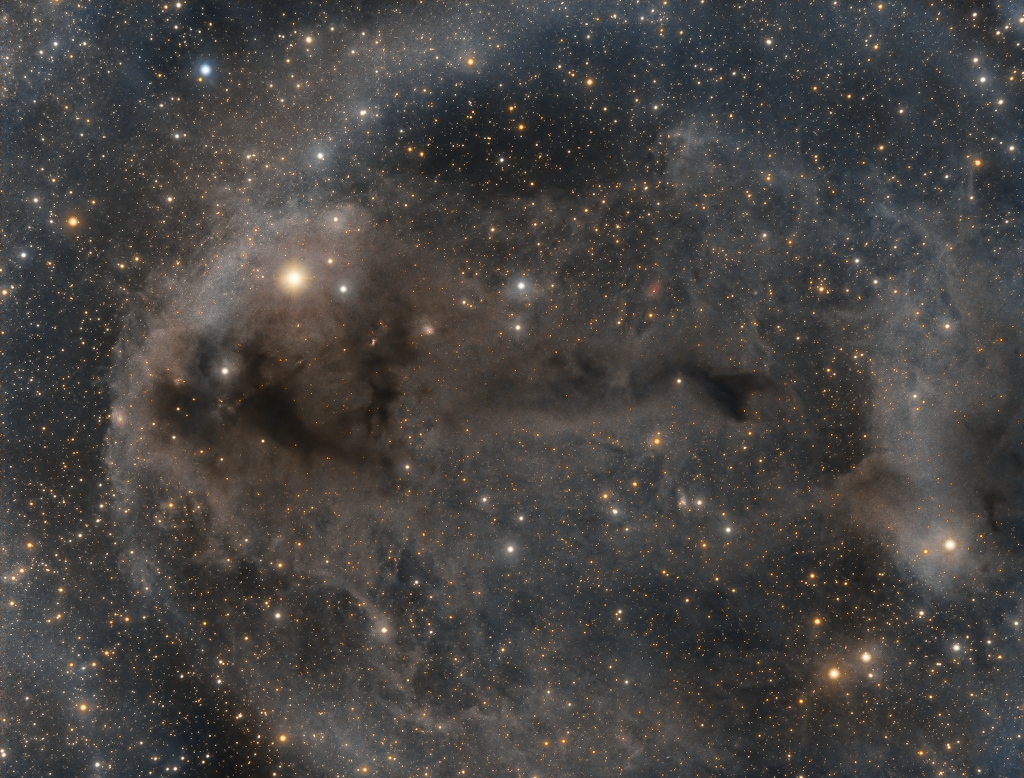Blog
https://www.youtube.com/watch?v=Io6HwRadjU4
more...Ten thousand years ago, before the dawn of recorded human history, a new light would have suddenly have appeared in the night sky and faded after a few weeks. Today we know this light was from asupernova, or exploding star, and record the expanding debris cloud as the Veil Nebula, a supernova remnant. This sharp telescopic view is centered on a western segment of the Veil Nebula cataloged as NGC 6960 but less formally known as the Witch’s Broom Nebula. Blasted out in the cataclysmic explosion, the interstellar shock wave plows through space sweeping up and exciting interstellar material. Imaged with narrow band filters, the glowing filaments are like long ripples in a sheet seen almost edge on, remarkably well separated into atomic hydrogen (red) and oxygen (blue-green) gas. The complete supernova remnant lies about 1400 light-years away towards the constellation Cygnus. This Witch’s Broom actually spans about 35 light-years. The bright star in the frame is 52 Cygni, visible with the unaided eye from a dark location but unrelated to the ancient supernova remnant.

William Harrison Withers Jr. (July 4, 1938 – March 30, 2020) was an American singer-songwriter and musician. He recorded several major hits, including “Ain’t No Sunshine” (1971), “Grandma’s Hands” (1971), “Use Me” (1972), “Lean on Me” (1972), “Lovely Day” (1977), and “Just the Two of Us” (1980). Withers won three Grammy Awards and was nominated for six more. His life was the subject of the 2009 documentary film Still Bill.[1] He was inducted into the Songwriters Hall of Fame in 2005 and Rock and Roll Hall of Fame in 2015. Two of his songs were inducted into the Grammy Hall of Fame. Withers worked as a professional musician for just 15 years, from 1970 to 1985, after which he moved on to other occupations.
Withers, the youngest of six children, was born in the small coal-mining town of Slab Fork, West Virginia on July 4, 1938. He was the son of Mattie (Galloway), a maid, and William Withers, a miner. He was born with a stutter and later said he had a hard time fitting in. His parents divorced when he was 3, and he was raised by his mother’s family in nearby Beckley. He was 13 years old when his father died. Withers enlisted in the United States Navy at the age of 17, and served for nine years, during which time he became interested in singing and writing songs.
He left the Navy in 1965, and relocated to Los Angeles in 1967 to start a music career. Withers worked as an assembler for several different companies, including Douglas Aircraft Corporation, while recording demo tapes with his own money, shopping them around and performing in clubs at night. When he debuted with the song “Ain’t No Sunshine” in 1971, he refused to resign from his job because he believed the music business was a fickle industry.
more...Fred Wesley (born July 4, 1943) is an American trombonist who worked with James Brown in the 1960s and 1970s and Parliament-Funkadelic in the second half of the 1970s.
Wesley was born the son of a high school teacher and big band leader in Columbus, Georgia, and raised in Mobile, Alabama. As a child he took piano and later trumpet lessons. He played baritone horn and trombone in school, and at around age 12 his father brought a trombone home, whereupon he switched (eventually permanently) to trombone.
During the 1960s and 1970s he was a pivotal member of James Brown‘s bands, playing on many hit recordings including “Say it Loud – I’m Black and I’m Proud,” “Mother Popcorn” and co-writing tunes such as “Hot Pants.” His slippery riffs and pungent, precise solos, complementing those of saxophonist Maceo Parker, gave Brown’s R&B, soul, and funk tunes their instrumental punch. In the 1970s he also served as band leader and musical director of Brown’s band the J.B.’s and did much of the composing and arranging for the group. His name was credited on ‘Fred Wesley & the J.B.’s’ recording of “Doing It to Death,” which sold over one million copies, and was awarded a gold disc by the R.I.A.A. in July 1973. He left Brown’s band in 1975 and spent several years playing with George Clinton‘s various Parliament-Funkadelic projects, even recording a couple of albums as the leader of a spin-off group, The Horny Horns.
Wesley became a force in jazz in 1978 when he joined the Count Basie Orchestra. He released his first jazz album as a leader, To Someone in 1988. It was followed by New Friends in 1990, Comme Ci Comme Ca in 1991, the live album Swing and Be Funky, and Amalgamation in 1994.
more...July 4th
A native of Norfolk, Virginia, Bernard’s fascination with the resounding thunder of the drum set began at an early age. His legacy of playing percussion is rooted in his childhood, where he was the drummer for his church choir at age 9. Bernard reflects on such greats as Elvin Jones and Jazz Messenger phenomenon Art Blakely and attributes Steve Ellington and Billy Higgins as major influences in his style. While studying at Rutgers University, Bernard formed invaluable and lifelong associations with some of the most respected names in Jazz, including Kenny Barron, Grady Tate, Michael Carvin, Larry Ridley, Paul Jefferey and Ted Dunbar. A proven and articulate clinician, Bernard served as part of a clinic conducted by the legendary saxophonist Sonny Stitt.After serving in the Armed Forces, Bernard began another life long association while working with pianist and vocalist Freddie Cole. Bernard credits his foundation for his understanding of the classic standards, swing arrangements, ballads and the art of voice performance to his work with Freddy Cole. Bernard has also performed with such greats as Little Jimmy Scott, Junior Cook, Cedar Walton, Donald Harrison and Abbey Lincoln. Through his energetic yet defined style, Bernard has won many well-deserved accolades in the world of Jazz. His sextet, inspired by Art Blakey’s Jazz Messengers strives for a well arranged blend of straight-ahead, latin and avant-garde grooves.
more...Stephen Collins Foster (July 4, 1826 – January 13, 1864), known as “the father of American music”, was an American songwriter known primarily for his parlor and minstrel music. He wrote more than 200 songs, including “Oh! Susanna“, “Hard Times Come Again No More“, “Camptown Races“, “Old Folks at Home” (“Swanee River”), “My Old Kentucky Home“, “Jeanie with the Light Brown Hair“, “Old Black Joe“, and “Beautiful Dreamer“, and many of his compositions remain popular today. He has been identified as “the most famous songwriter of the nineteenth century” and may be the most recognizable American composer in other countries. Most of his handwritten music manuscripts are lost, but editions issued by publishers of his day feature in various collections.
more...This tune commemorates the Sir Henry Clinton’s, Commander of the British forces, storming of Stony Point in 1779. General George Washington managed to outsmart Clinton, and staged to a maneuver to retake Stony Point with the help of General Anthony Wayne, which was eventually successful.
more...https://www.youtube.com/watch?v=rlTFKt3tNow
more...Rhoda Scott (born July 3, 1938) is an American soul jazz organist.
Scott was first attracted to the organ in her father’s church at age seven. “It’s really the most beautiful instrument in the world”, she stated in a recent interview. “The first thing I did was take my shoes off and work the pedals.” From then on she always played her church organ in her bare feet, and to this date she has continued the practice.
In 1967 Scott moved to France, where she has since spent most of her career.
more...Stars are forming in Lynds Dark Nebula (LDN) 1251. About 1,000 light-years away and drifting above the plane of our Milky Way galaxy, the dusty molecular cloud is part of a complex of dark nebulae mapped toward the Cepheus flare region. Across the spectrum, astronomical explorations of the obscuring interstellar clouds reveal energetic shocks and outflows associated with newborn stars, including the telltale reddish glow from scattered Herbig-Haro objects seen in this sharp image. Distant background galaxies also lurk on the scene, buried behind the dusty expanse. This alluring view imaged with a backyard telescope and broadband filters spans about two full moons on the sky, or 17 light-years at the estimated distance of LDN 1251.

Lonnie Smith (born July 3, 1942), styled Dr. Lonnie Smith, is an American jazz Hammond B3 organist who was a member of the George Benson quartet in the 1960s. He recorded albums with saxophonist Lou Donaldson for Blue Note before being signed as a solo act. He owns the label Pilgrimage.
He was born in Lackawanna, New York, into a family with a vocal group and radio program. Smith says that his mother was a major influence on him musically, as she introduced him to gospel, classical, and jazz music. He was part of several vocal ensembles in the 1950s, including the Teen Kings which included Grover Washington Jr., on sax and his brother Daryl on drums. Art Kubera, the owner of a local music store, gave Smith his first organ, a Hammond B3. George Benson Quartet
Smith’s affinity for R&B melded with his own personal style as he became active in the local music scene. He moved to New York City, where he met George Benson, the guitarist for Jack McDuff‘s band. Benson and Smith connected on a personal level, and the two formed the George Benson Quartet, featuring Lonnie Smith, in 1966.
After two albums under Benson’s leadership, It’s Uptown and Cookbook, Smith recorded his first solo album (Finger Lickin’ Good Soul Organ) in 1967, with George Benson and Melvin Sparks on guitar, Ronnie Cuber on baritone sax, and Marion Booker on drums. This combination remained stable for the next five years.
After recording several albums with Benson, Smith became a solo recording artist and has since recorded over 30 albums under his own name. Numerous prominent jazz artists have joined Smith on his albums and in his live performances, including Lee Morgan, David “Fathead” Newman, King Curtis, Terry Bradds, Blue Mitchell, Joey DeFrancesco and Joe Lovano.
more...John Heard is a bass player and artist. He has worked with Pharoah Sanders, playing on his Heart is a Melody album, George Duke playing on the Jean-Luc Ponty Experience with the George Duke Trio album and Oscar Petersons The London Concert album. he also played on the Night Rider by Oscar Peterson and Count Basie.
He was born John William Heard in July 1938.
He also played saxophone in his early years. He began playing bass at the age of 14. His professional career began in a band that included sax player Booker Ervin, drummer J.C. Moses, pianist Horace Parlan and trumpet player Tommy Turrentine. Whilst still at high school, he attended special classes at the Carnegie Museum of Art.
In 1958 he joined the air force and was sent to Germany. Because of his art experience he was given a job of designing posters for events. He also did some art teaching, teaching the wives of officers. He left the air force in 1961 and enrolled at the Art Institute of Pittsburgh. He returned to music and went to Buffalo and later to California.
more...John Coles (July 3, 1926 – December 21, 1997) was an American jazz trumpeter.
Coles was born in Trenton, New Jersey on July 3, 1926. He grew up in Philadelphia and was self-taught on trumpet.
Coles spent his early career playing with R&B groups, including those of Eddie Vinson (1948–1951), Bull Moose Jackson (1952), and Earl Bostic (1955–1956). He was with James Moody from 1956 to 1958, and played with Gil Evans‘s orchestra between 1958 and 1964, including for the album Out of the Cool. After this he spent time with Charles Mingus in his sextet which also included Eric Dolphy, Clifford Jordan, Jaki Byard, and Dannie Richmond. Following this he played with Herbie Hancock (1968–1969), Ray Charles (1969–1971), Duke Ellington (1971–1974), Art Blakey (1976), Dameronia, Mingus Dynasty, and the Count Basie Orchestra under the direction of Thad Jones (1985–1986).
In 1985 Coles settled in the San Francisco Bay area; he recorded with Frank Morgan and Chico Freeman the following year. After his return to Philadelphia in 1989 he again worked with Morgan and was part of Gene Harris‘s Philip Morris Superband. In 1990 he recorded with Charles Earland and Buck Hill. Coles recorded as a leader several times over the course of his career. He died of cancer on December 21, 1997 in Philadelphia.
more...Solea is one of the heavy hitters of all of palos (rhythms) of flamenco. It’s profound, somber and the mother of all palos (imho).
It’s a 12 count, but unlike the other 12 count palos, this one tends to start on 1 rather than the 12 for the letra. Also, the end of the compás is emphasized.
1 – 2 – 3 – 4 – 5 – 6 – 7 – 8 – 9 – 10 – 11 –12
The structure of a dance of Solea is similar to all the others:
- Salida (singer & guitarist start, dancer makes entrance)
- Llamada (rhythmical accent from dancer that “calls” the singer to sing)
- 1st Letra (1st verse)
- Llamada
- 2nd Letra
- Falseta (guitar interlude)
- Escobilla (footwork section)
- Buleria (fast ending letra)
- Estribillo (chorus that the dancer ends with)
Of course, there are many variations to this structure. There can be more letras and falsetas. Or there can be more spots for different escobillas. The dancer could even add a letra of Solea por Bulerias after the letras of Solea and before the Buleria. Options!!! Choices!!!
more...The Gemini South Multi-Object Spectograph (GMOS) recently captured a dramatic image of a vast cloud complex named DEM L316 located in the Large Magellanic Cloud. The peanut-shaped nebula appears to be a single object, but the latest research indicates that it is really comprised of two distinct gas and dust clouds formed by different types of supernova explosions.
The new image reveals the intricate tendrils of gas and dust located in the remnants of the stellar explosions that created the still-expanding cloud complex. The object was first recognized in the early 1970s as a supernova remnant, a type of object that is enriched with elements created in stellar explosions. The nebula was likely created a few tens of thousands of years ago by more than one type of supernova exploding in this region of the Large Magellanic Cloud.
“The remarkable clarity of these Gemini-South observations shows the complex shock structure of these two supernova remnants in impressive detail,” said Dr. Rosa Williams of Columbus State University, an astronomer who has studied DEM L316 extensively. “It’s a great step forward in efforts to understand this fascinating pair of remnants – whether they represent only a chance alignment on the sky or some as-yet uncovered physical relationship.”
Other recent observations of DEM L316 by the Chandra and XMM-Newton X-ray space telescopes have strengthened the idea that the cloud is actually two supernova remnants that are aligned in the sky by chance and not a single remnant with a distorted bi-polar shape. The Chandra observations reveal that the chemical compositions of the two shells are very different. This is a strong hint that they were created in very different types of supernova outbursts. The data show that the smaller shell (lower left in the GMOS image) contains significantly more iron than the larger one. The high abundance of iron in the small bubble indicates that the gas is the product of a Type Ia supernova. This type of explosion is triggered by the infall of matter from a star onto a white dwarf. Since white dwarf stars are extremely old objects, the system must have been a few billion years old when this supernova explosion took place.

Charles Robert Watts (born 2 June 1941) is an English drummer, best known as a member of the Rolling Stones since 1963. Originally trained as a graphic artist, he started playing drums in London’s rhythm and blues clubs, where he met Brian Jones, Mick Jagger, and Keith Richards. In January 1963, he joined their fledgling group, the Rolling Stones, as drummer, while doubling as designer of their record sleeves and tour stages. Watts cites jazz as a major influence on his drumming style. He has toured with his own group, the Charlie Watts Quintet, and appeared in London at Ronnie Scott’s Jazz Club with the Charlie Watts Tentet.
In 2006, Watts was elected into the Modern Drummer Hall of Fame; in the same year, Vanity Fair elected him into the International Best Dressed List Hall of Fame. In the estimation of noted music critic Robert Christgau, Watts is “rock’s greatest drummer.” In 2016, he was ranked 12th on Rolling Stone‘s “100 Greatest Drummers of All Time” list.
more...More Posts
- Pippin the Musical performing at Mixed Blood Theater
- The Cosmos with Zeta Ophiuchi
- Joseph Jarman Day
- Israel “Cachao” Lopez Dia
- Giorgos Papasideris Day
- World Fusion with Karim Dabo feat Mafé
- Daily Roots with Chris Murray and the Slackers
- Harvest Moon tonight 9-13-19
- Pippin Opening Tonight with Theater 55
- Friday the 13th & Knights Templar
- The Cosmos with M51
- Charles Brown Day
- Chu Berry Day
- Bill Monroe Day
- World Music with Ricardo Modrego y Paco de Lucia
- Daily Roots with Busty Brown
- The Cosmos with NGC 7023
- Maria Muldaur Day
- Papa John DeFrancesco Day
- Cat Anderson Day
